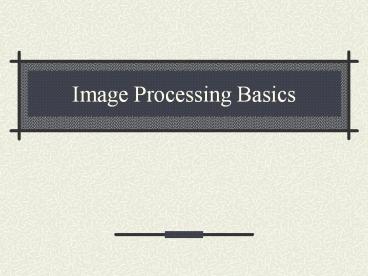Image Processing Basics PowerPoint PPT Presentation
1 / 33
Title: Image Processing Basics
1
Image Processing Basics
2
What are images?
- An image is a 2-d rectilinear array of pixels
3
Pixels as samples
- A pixel is a sample of a continuous function
4
Images are Ubiquitous
- Input
- Optical photoreceptors
- Digital camera CCD array
- Rays in virtual camera (why?)
- Output
- TVs
- Computer monitors
- Printers
5
Properties of Images
- Spatial resolution
- Width pixels/width cm and height pixels/ height
cm - Intensity resolution
- Intensity bits/intensity range (per channel)
- Number of channels
- RGB is 3 channels, grayscale is one channel
6
Image errors
- Spatial aliasing
- Not enough spatial resolution
- Intensity quantization
- Not enough intensity resolution
7
Two issues
- Sampling and reconstruction
- Creating and displaying images while reducing
spatial aliasing errors - Halftoning techniques
- Dealing with intensity quantization
8
Sampling and reconstruction
9
Aliasing
- Artifacts caused by too low sampling frequency
(undersampling) or improper reconstruction - Undersampling rate determined by Nyquist limit
(Shannons sampling theorem)
10
Aliasing in computer graphics
- In graphics, two major types
- Spatial aliasing
- Problems in individual images
- Temporal aliasing
- Problems in image sequences (motion)
11
Spatial Aliasing
- Jaggies
12
Spatial aliasing
Ref SIGGRAPH aliasing tutorial
13
Spatial aliasing
- Texture disintegration
Ref SIGGRAPH aliasing tutorial
14
Temporal aliasing
- Strobing
- Stagecoach wheels in movies
- Flickering
- Monitor refresh too slow
- Frame update rate too slow
- CRTs seen on other video screens
15
Antialiasing
- Sample at a higher rate
- What if the signal isnt bandlimited?
- What if we cant do this, say because the
sampling device has a fixed resolution? - Pre-filter to form bandlimited signal
- Low pass filter
- Trades aliasing for blurring
- Non-uniform sampling
- Not always possible, done by your visual system,
suitable for ray tracing - Trades aliasing for noise
16
Sampling Theory
- Two issues
- What sampling rate suffices to allow a given
continuous signal to be reconstructed from a
discrete sample without loss of information? - What signals can be reconstructed without loss
for a given sampling rate?
17
Spectral Analysis
- Spatial (time) domain
- Frequency domain
Any (spatial, time) domain signal (function) can
be written as a sum of periodic functions
(Fourier)
18
Fourier Transform
19
Fourier Transform
- Fourier transform
- Inverse Fourier transform
20
Sampling theorem
- A signal can be reconstructed from its samples if
the signal contains no frequencies above ½ the
sampling frequency. - -Claude Shannon
- The minimum sampling rate for a bandlimited
signal is called the Nyquist rate - A signal is bandlimited if all frequencies above
a given finite bound have 0 coefficients, i.e. it
contains no frequencies above this bound.
21
Filtering and convolution
- Convolution of two functions ( filtering)
- Convolution theorem
- Convolution in the frequency domain is the same
as multiplication in the spatial (time) domain,
and - Convolution in the spatial (time) domain is the
same as multiplication in the frequency domain
22
Filtering, sampling and image processing
- Many image processing operations basically
involve filtering and resampling. - Blurring
- Edge detection
- Scaling
- Rotation
- Warping
23
Resampling
- Consider reducing the image resolution
24
Resampling
- The problem is to resample the image in such a
way as to produce a new image, with a lower
resolution, without introducing aliasing. - Strategy-
- Low pass filter transformed image by convolution
to form bandlimited signal - This will blur the image, but avoid aliasing
25
Ideal low pass filter
- Frequency domain
- Spatial (time) domain
26
Image processing in practice
- Use finite, discrete filters instead of infinite
continous filters - Convolution is a summation of a finite number of
terms rather than in integral over an infinite
domain - A filter can now be represented as an array of
discrete terms (the kernel)
27
Discrete Convolution
28
Finite low pass filters
- Triangle filter
29
Finite low pass filters
- Gaussian filter
30
Edge Detection
- Convolve image with a filter that finds
differences between neighboring pixels
31
Scaling
- Resample with a gaussian or triangle filter
32
Image processing
- Some other filters
33
Summary
- Images are discrete objects
- Pixels are samples
- Images have limited resolution
- Sampling and reconstruction
- Reduce visual artifacts caused by aliasing
- Filter to avoid undersampling
- Blurring (and noise) are preferable to aliasing

